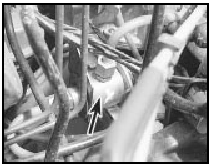Fuel pressure regulator - removal and refitting
Note: Refer to the precautions at the end of Section 1 before proceeding.
Removal
1 The fuel pressure regulator is only used on
KE-Jetronic systems and is located behind
the fuel distributor (see illustration).

13.1 KE-Jetronic fuel pressure regulator location (arrowed) behind fuel
distributor
2 Disconnect the battery negative lead.
3 Relieve the system pressure by slowly loosening the cold start valve union on the top of the fuel distributor (see illustration 6.4).
Absorb fuel leakage in a cloth.
4 Place absorbent cloth beneath the regulator and undo the two fuel feed unions and the fuel return union. Note the pipe locations to ensure correct refitting.
5 Remove the securing tie and withdraw the regulator from its bracket.
Refitting
6 Refitting is a reversal of removal. Ensure
that all unions are correctly reconnected and
secure, and on completion check for fuel leaks
with the engine running (see illustration).

13.6 KE-Jetronic fuel pressure regulator pipe connections
A Fuel feed B Fuel return
5 Remove the securing tie and withdraw the regulator from its bracket.
Refitting
6 Refitting is a reversal of removal. Ensure
that all unions are correctly reconnected and
secure, and on completion check for fuel leaks
with the engine running (see illustration).
See also:
Cylinder head - removal and refitting
Carburettor engines
Removal
Note: The cylinder head must only be
removed when the engine is cold. New
cylinder head bolts and a new gasket must be
used on refitting.
1 Disconnect the battery ear ...
Crankcase emission control filter renewal - CVH engines (Every
24 000 miles or 2 Years)
Carburettor and Central Fuel
Injection (CFI) engines
1 Where fitted, the crankcase ventilation filter
is located in the base of the air cleaner.
2 The filter can be renewed by pulling it out of
t ...
Steering wheel - removal and refitting
Removal
1 Set the front wheels in the straight-ahead
position.
2 Prise the trim insert from the centre of the
steering wheel, and where applicable,
disconnect the horn electrical lead(s) (see
il ...
